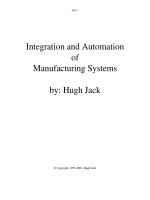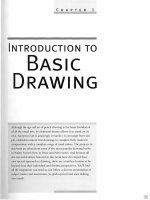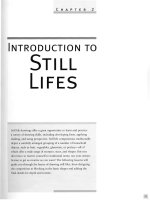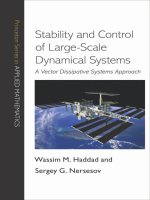stability and control of aircraft systems introduction to classical feedback control pdf
Bạn đang xem bản rút gọn của tài liệu. Xem và tải ngay bản đầy đủ của tài liệu tại đây (1.77 MB, 257 trang )
www.EngineeringBooksPDF.com
Stability and Control of
Aircraft Systems
Introduction to Classical
Feedback Control
Roy Langton
www.EngineeringBooksPDF.com
www.EngineeringBooksPDF.com
Stability and Control of Aircraft
Systems
www.EngineeringBooksPDF.com
www.EngineeringBooksPDF.com
Stability and Control of
Aircraft Systems
Introduction to Classical
Feedback Control
Roy Langton
www.EngineeringBooksPDF.com
Copyright © 2006
John Wiley & Sons Ltd, The Atrium, Southern Gate, Chichester,
West Sussex PO19 8SQ, England
Telephone
(+44) 1243 779777
Email (for orders and customer service enquiries):
Visit our Home Page on www.wiley.com
All Rights Reserved. No part of this publication may be reproduced, stored in a retrieval system or
transmitted in any form or by any means, electronic, mechanical, photocopying, recording, scanning or
otherwise, except under the terms of the Copyright, Designs and Patents Act 1988 or under the terms of a
licence issued by the Copyright Licensing Agency Ltd, 90 Tottenham Court Road, London W1T 4LP, UK,
without the permission in writing of the Publisher. Requests to the Publisher should be addressed to the
Permissions Department, John Wiley & Sons Ltd, The Atrium, Southern Gate, Chichester, West Sussex
PO19 8SQ, England, or emailed to , or faxed to (+44) 1243 770620.
Designations used by companies to distinguish their products are often claimed as trademarks. All brand
names and product names used in this book are trade names, service marks, trademarks or registered
trademarks of their respective owners. The Publisher is not associated with any product or vendor
mentioned in this book.
This publication is designed to provide accurate and authoritative information in regard to the subject
matter covered. It is sold on the understanding that the Publisher is not engaged in rendering professional
services. If professional advice or other expert assistance is required, the services of a competent
professional should be sought.
Other Wiley Editorial Offices
John Wiley & Sons Inc., 111 River Street, Hoboken, NJ 07030, USA
Jossey-Bass, 989 Market Street, San Francisco, CA 94103-1741, USA
Wiley-VCH Verlag GmbH, Boschstr. 12, D-69469 Weinheim, Germany
John Wiley & Sons Australia Ltd, 42 McDougall Street, Milton, Queensland 4064, Australia
John Wiley & Sons (Asia) Pte Ltd, 2 Clementi Loop #02-01, Jin Xing Distripark, Singapore 129809
John Wiley & Sons Canada Ltd, 22 Worcester Road, Etobicoke, Ontario, Canada M9W 1L1
Wiley also publishes its books in a variety of electronic formats. Some content that appears in print may
not be available in electronic books.
Library of Congress Cataloging in Publication Data
Langton, Roy.
Stability and control of aircraft systems : introduction to classical feedback control / Roy Langton.
p. cm.
ISBN 0-470-01891-7
1. Stability of airplanes. 2. Airplanes—Control. I. Title
TL574.S7L35 2006
629.132 36—dc22
2006015974
British Library Cataloguing in Publication Data
A catalogue record for this book is available from the British Library
ISBN-13 978-0-470-01891-0 (HB)
ISBN-10 0-470-01891-7 (HB)
Typeset in 10.5/12.5pt Palatino by Integra Software Services Pvt. Ltd, Pondicherry, India
Printed and bound in Great Britain by TJ International, Padstow, Cornwall
This book is printed on acid-free paper responsibly manufactured from sustainable forestry in which at
least two trees are planted for each one used for paper production.
www.EngineeringBooksPDF.com
Contents
Series Preface
ix
Preface
xi
1 Developing the Foundation
1.1 Engineering Units
1.1.1 International System of Units (SI)
1.1.2 US/Imperial Units System
1.1.3 Comparing the SI and US/Imperial Units Systems
1.2 Block Diagrams
1.2.1 Examples of Summation (or Comparison) Devices
1.3 Differential Equations
1.3.1 Using the ‘D’ Notation
1.4 Spring–Mass System Example
1.4.1 The Standard Form of Second-order System Transfer
Function
1.5 Primer on Complex Numbers
1.5.1 The Complex Sinusoid
1.6 Chapter Summary
1
2
2
3
4
4
5
11
12
14
2 Closing the Loop
2.1 The Generic Closed Loop System
2.1.1 The Simplest Form of Closed Loop System
2.2 The Concept of Stability
23
23
24
26
www.EngineeringBooksPDF.com
15
18
19
21
vi
Contents
2.3
2.4
2.5
2.6
Response Testing of Control Systems
The Integration Process
Hydraulic Servo-actuator Example
Calculating Frequency Response
2.6.1 Frequency Response of a First-order Lag
2.6.2 Frequency Response of a Second-order System
2.7 Aircraft Flight Control System Example
2.7.1 Control System Assumptions
2.7.2 Open Loop Analysis
2.7.3 Closed Loop Performance
2.8 Alternative Graphical Methods for Response Analysis
2.8.1 The Nyquist Diagram
2.8.2 Deriving Closed Loop Response from Nyquist
Diagrams
2.8.3 The Nichols Chart
2.8.4 Graphical Methods – Summary Comments and
Suggestions
2.9 Chapter Summary
28
32
37
40
43
45
47
48
49
53
54
54
3 Control System Compensation Techniques
3.1 Control System Requirements
3.2 Compensation Methods
3.2.1 Proportional Plus Integral Control
3.2.2 Proportional Plus Integral Plus Derivative Control
3.2.3 Lead–Lag Compensation
3.2.4 Lag–Lead Compensation
3.2.5 Feedback Compensation
3.3 Applications of Control Compensation
3.3.1 Proportional Plus Integral Example
3.3.2 Lead–Lag Compensation Example
3.3.3 Class 2 System Design Example
3.4 Chapter Summary
71
71
72
73
76
78
81
84
89
89
97
101
114
4 Introduction to Laplace Transforms
4.1 An Overview of the Application of Laplace Transforms
4.2 The Evolution of the Laplace Transform
4.2.1 Proof of the General Case
4.3 Applying Laplace Transforms to Linear Systems
Analysis
4.3.1 Partial Fractions
117
117
118
121
www.EngineeringBooksPDF.com
59
62
66
68
124
129
Contents
vii
4.4 Laplace Transforms – Summary of Key Points
4.5 Root Locus
4.5.1 Root Locus Construction Rules
4.5.2 Connecting Root Locus to Conventional Linear
Analysis
4.6 Root Locus Example
4.7 Chapter Summary
138
140
141
146
152
155
5 Dealing with Nonlinearities
5.1 Definition of Nonlinearity Types
5.2 Continuous Nonlinearities
5.2.1 Engine Fuel Control System Example
5.3 Discontinuous Nonlinearities
5.3.1 Stability Analysis with Discontinuous Nonlinearities
5.4 The Transport Delay
5.5 Simulation
5.6 Chapter Summary
157
157
159
161
167
172
176
179
188
6 Electronic Controls
6.1 Analog Electronic Controls
6.1.1 The Operational Amplifier
6.1.2 Building Analog Control Algorithms
6.2 The Digital Computer as a Dynamic Control Element
6.2.1 Signal Conversion
6.2.2 Digital Controller Architectures
6.3 The Stability Impact of Digital Controls
6.4 Digital Control Design Example
6.5 Creating Digital Control Algorithms
6.5.1 The Integrator
6.5.2 The First-order Lag
6.5.3 The Pseudo Derivative
6.6 Chapter Summary
191
193
194
195
197
197
201
206
210
215
215
216
217
218
7 Concluding Commentary
7.1 An Overview of the Material
7.2 Graphical Tools
7.3 Compensation Techniques
7.3.1 Integral Wind-up
7.3.2 Avoid Using Pure Derivative Action
7.3.3 Mechanical Stiffness Estimates are Always High
221
222
225
227
227
228
228
www.EngineeringBooksPDF.com
viii
Contents
7.4
7.5
7.6
7.7
Laplace Transforms and Root Locus Techniques
Nonlinearities
Digital Electronic Control
The Way Forward
Index
229
230
232
233
235
www.EngineeringBooksPDF.com
Series Preface
The field of aerospace is wide ranging and covers a variety of products,
disciplines and domains, not merely in engineering but in many related
supporting activities. These combine to enable the aerospace industry
to produce exciting and technologically challenging products. A wealth
of knowledge is contained by practitioners and professionals in the
aerospace fields that is of benefit to other practitioners in the industry,
and to those entering the industry from University.
The Aerospace Series aims to be a practical and topical series of books
aimed at engineering professional, operators, users and allied professions such as commercial and legal executives in the aerospace industry.
The range of topics spans design and development, manufacture, operation and support of aircraft as well as infrastructure operations, and
developments in research and technology. The intention is to provide a
source of relevant information that will be of interest and benefit to all
those people working in aerospace.
Ian Moir, Allan Seabridge and Roy Langton
www.EngineeringBooksPDF.com
www.EngineeringBooksPDF.com
Preface
There are many textbooks on the subject of feedback control; however,
most are highly mathematical and, as a result, often repel the seasoned
engineer who may have become a little rusty regarding the rigors of
certain aspects of mathematics that include such things as differential
equations and complex number theory. In a similar manner, unnecessarily complex mathematics can be a turnoff to engineering students
who might otherwise find the control systems engineering field both
challenging and exciting.
This book is not a textbook in the traditional sense but an attempt
by the author to give back to the next generation of control systems
engineers a guidebook containing easy to follow descriptions of the
important aspects of classical control supported by examples based on
real world events that have occurred during the author’s career in the
aerospace industry. The arrangement and content of the book is an
attempt to provide an effective answer to the question ‘What would
have been most useful to me as a prospective systems engineer in the
pre-to-post graduate timeframe seeking guidance and insight into the
fundamentals of feedback control?’.
In the opinion of the author, complex mathematics need not be a
significant barrier to learning if a pragmatic presentation methodology
can be developed providing a more straightforward approach to the
subject that can be more easily absorbed by the practicing engineer
and that provides an inspiration to the prospective control engineering
graduate.
In the current world of increasing complexity and functional integration in all areas of engineering and technology, the engineer who
did not take the course on ‘stability and control’ operates at a serious
www.EngineeringBooksPDF.com
xii
Preface
disadvantage. This is a common issue amongst many older mechanical
engineering graduates because historically control theory has been a part
of the electrical engineering curriculum. Even though this is becoming
less typical in most learning institutions the seasoned engineer with
a mechanical engineering background has, more often than not, never
been exposed to the subject of feedback control theory. An additional
problem with academia is the fact that much of the material taught is not
in common practice within the industry. As a result the learning experience becomes more of a mathematical exercise that misses out many
of the pragmatic methods that have been established as most effective
in the design and development departments of industry.
Today’s engineers are required more and more to be both specialists
in their area of expertise and generalists who understand the complete
functional context of the application where their products are being used.
Also, many of today’s products contain multiple engineering technologies. What once were single discipline mechanical, hydraulic or pneumatic products and systems now contain integrated electronic sensors
and, in many instances today, software. Control theory reduces these
widely varied technical disciplines into their important dynamic characteristics expressed as transfer functions from which the subtleties of
dynamic behavior can be analyzed and understood.
The objective of this introductory book on feedback control is developed around the generic closed loop control system concept illustrated
by the diagram of Figure 0.1: As shown, the typical system comprises a
Disturbance
Process
requirements
Process
response
Controller
Effector
Process
Figure 0.1 Generic feedback control system
www.EngineeringBooksPDF.com
Preface
xiii
control element, an effector and a process to be controlled. The process
requirements are compared with the process response in the controller
whose task is to generate actions that ultimately bring the process in
line with the required state. The effector represents a power amplification stage or ‘muscle’ that takes the control output signals and converts
them into a form that can be used to effect a change in the process. The
process may be any number of things from a simple actuator to a major
aircraft control system. The arrow connecting the process response to
the controller represents the feedback of process states to the controller,
hence the term feedback loop. The effector may also incorporate feedback to the controller as indicated by the shaded arrow.
An important feature of the feedback control system is that external
disturbances which affect the response of the process will be sensed,
and ultimately compensated for, by the ensuing corrective action determined by the controller. The challenge for the control system designer
is to establish the best control algorithm that will provide the optimum
performance in terms of accuracy, dynamic response and stability. The
objective of this book is to provide the reader with the basic tools to
understand the design processes and to visualize the functional behavior
associated with feedback control systems.
As part of the aerospace series the material presented in this book is
related to aircraft control system situations almost exclusively. Furthermore, the extensive background of the author in the areas of flight
controls, hydraulics, fuel and engine control systems forms the basis for
many of the design examples and reinforcement exercises developed.
At this point it is appropriate for the reader to recognize that aircraft
closed loop control systems vary substantially in their criticality and
response needs. While the primary focus of this book on stability and
control is aimed at the tightly coupled fast response systems where
stability and response requirements are important design and operational issues often with demanding specifications, there are many interactive control systems within a typical aircraft that are much more
loosely coupled but nevertheless must be recognized and evaluated
from a response and performance perspective. Figure 0.2 illustrates this
point by showing schematically the functional relationship between the
various layers of functionality associated with the control of a modern
aircraft.
Shown in Figure 0.2 are a number of nested control loops with control
surface actuators at the center which determine the immediate aircraft
response and attitude. At the second level is the flight director/autopilot
www.EngineeringBooksPDF.com
xiv
Preface
Flight Deck
Pilot controls
MCDU
Autopilot
Column
Throttle
Displays
oo o
Flaps
Pedals
Flight
Management
Avionics
Flight
Director
Avionics
Trajectory
Fly-By-Wire
Control
Avionics
Surface
Actuators
Aircraft
Sensors
Attitude
Flight mission
Figure 0.2 Typical integrated flight control system
control loop which determines the trajectory of the aircraft within its
local airspace. Around these two control loops is the navigation system
which controls the aircraft’s mission through space relative to Earth
coordinates.
The outer loops become less tightly coupled but they are by definition closed loop control systems and as such must be recognized by
the control systems engineer in terms of response needs and potential interaction between the various control layers. These comments are
presented here to provide a perspective and awareness to the reader of
the complexity of the modern aircraft in terms of stability and control
and to be cognizant of the additional ‘outer’ control loops that are invariably involved in the overall performance of the aircraft.
While the intent of this book is to minimize the mathematical content,
all of the key analytical procedures are developed from first principles
in the interest of completeness and to satisfy the reader with a strong
interest in the mathematics. The underlying methodologies, graphical
aids and guidelines described, however, can be developed using fairly
simple algebraic principles that are intended to provide the practitioner
with a good ‘feel for the problem’.
www.EngineeringBooksPDF.com
Preface
xv
Part of the fascination of understanding the principles of feedback
control is learning to be able to appreciate the functional behavior of
control systems through the interpretation of simple block diagrams
and to appreciate the fact that the dynamic functionality of complex
integrated systems is typically not intuitive.
The author has a long-standing belief that a basic understanding
of feedback control systems design, analysis and testing allows the
design/development engineer to have a clearer understanding of the
dynamic functional behavior that results when multiple components are
combined within a system to form an integrated functional entity.
The end objective of this book, therefore, is in effect to ‘switch on the
light’ in the dark room of system design and development for those
engineers who missed the opportunity to complete formal training in
control theory at university. This will provide the know-how necessary
to minimize problems with fielded systems in the area of operational
performance thus increasing the readers’ effectiveness in the eyes of
both their employers and their customers.
Roy Langton
www.EngineeringBooksPDF.com
www.EngineeringBooksPDF.com
1
Developing the
Foundation
Classical feedback control theory is an inherently mathematical subject
and as such can scare off the would-be practitioner if presented in
rigorous mathematical form. While there is no way to fully absorb and
apply the basic concepts of feedback control without any mathematics
it is definitely possible to ease into the subject matter gradually thus
allowing the reader to pursue with some curiosity, and hopefully some
excitement, the subtleties of closed loop system behavior.
This chapter attempts to provide the reader with a basic understanding
of the terminology associated with control theory and through the use of
simple examples to familiarize the reader with some of the key mathematical tools needed to apply feedback control principles to engineering
problems. To begin with we need to discuss the issue of engineering
units since there are fundamental differences between the standards in
use at teaching institutions and within industry both in Europe and
the United States. This is followed by a discussion regarding the use
of block diagrams as a way to describe the functionality of closed loop
control systems. Differential equations describe the dynamic behavior
of physical systems and are at the core of feedback control theory. Here,
however, they are transformed from the mathematics domain into an
easy to assimilate block diagram form using simple examples.
Stability and Control of Aircraft Systems: Introduction to Classical Feedback Control
© 2006 John Wiley & Sons, Ltd
R. Langton
www.EngineeringBooksPDF.com
2
Developing the Foundation
Finally, a brief refresher on the subject of complex number theory
is presented since there is no way to avoid this aspect of mathematics
in describing oscillatory behavior which is such an important part of
the process for defining closed loop system response and stability to
be developed and discussed later. Throughout this chapter, and also
throughout the rest of this book, every attempt is made to use simple
examples to reinforce the learning process and to present the material
in an easy-to-follow manner using a minimum of complicated mathematics.
1.1 Engineering Units
An important aspect of understanding control systems involves verifying the meaning of equations by analyzing the units associated with
the various constants and variables used. For completeness two unit
standards are addressed here in order to represent adequately the
academic and industrial backgrounds of readers from both Europe and
the United States.
In Europe the International System of Units (SI) has been adopted as
the standard in both academia and industry, while in the United States,
the SI system taught almost exclusively in universities is by no means the
standard of industry where the US/Imperial standards are still used by
the majority. Perhaps the most significant difference between the SI and
US/Imperial systems is regarding the treatment of mass and inertia and
their relationships with linear and angular acceleration. The following
section addresses this aspect of the two units systems before comparing
and reconciling them into a common method of understanding.
1.1.1 International System of Units (SI)
In this system the kilogram (kg) is used to define the mass of an object
representing its inertial resistance to acceleration. Force is expressed in
‘newtons’ (N) and acceleration in meters per second2 (ms−2 ).
Considering the basic equation:
force = mass × acceleration F = m × a
The SI system requires that a force of 1 newton applied to a mass of
1 kilogram will result in an acceleration of 1 meter per second2 .
www.EngineeringBooksPDF.com
Engineering Units
3
For the equation above to balance, the units of newtons must be
equivalent to kg m s−2 , that is:
kg m s−2 = kg × m s−2
Using the same logic we can express the units of kilogram mass as:
kg = N/m s−2
Thus we have expressed mass as a force per unit acceleration.
1.1.2 US/Imperial Units System
The imperial units system (adopted with a number of modifications by
the United States) developed from the fact that the local gravitational
force is always the same and equal to:
g = 32 2 ft/sec2
or 386 4 in /sec2
The basic equation: force = mass × acceleration is reconciled by defining
mass as weight divided by g so that:
F = W /g × acceleration
Here the unit-balance equation is:
lb = lb/ft sec−2 × ft sec−2
For most aerospace engineering problems inches (in.) are used for
displacement rather than feet (ft) for obvious reasons of scale.
An alternative method widely in use is to express the mass term
as pounds mass (lbm ) and force as pounds force (lbf ); however, for
simplicity we will adopt the convention where pounds (lb) always represents force and mass is expressed as the inertial force resisting acceleration in lb per unit acceleration, i.e. lb/ ft sec−2 .
www.EngineeringBooksPDF.com
4
Developing the Foundation
1.1.3 Comparing the SI and US/Imperial Units Systems
Going back to the basic equation the SI system denotes:
force N = mass kg × acceleration m s2
We can also express this equation as follows:
force N = inertial resistance N/m s2 × acceleration m/s2
This is now in the same form as the US/Imperial representation, that is:
force lb = inertial resistance lb/ft sec−2 × acceleration ft/sec2
This same approach can be readily applied to the rotational equivalent
of the above linear examples where:
torque = polar rotational inertia × rotational acceleration
The units equations for the SI and US/Imperial systems are as follows,
respectively:
N m = N m/ r/s2 × r/s2 and lb ft = lb ft/ rads/sec2 × rads/sec2
The intent of the above is to point out that both unit standards can
be expressed in a similar manner. The interpretation above is used
throughout this book because it is considered to be the most intuitive to
the reader.
1.2 Block Diagrams
Block diagrams are used extensively by control systems engineers to
provide a visual insight into the functionality of closed loop control
systems; it is therefore important for the reader to get comfortable with
www.EngineeringBooksPDF.com
Block Diagrams
5
this concept. Block diagrams are a convenient way to depict the various
elements of a control system as a number of interconnected boxes or
blocks wherein the input to a box/block multiplied by the contents of
the box/block defines the output from that box/block.
The contents of blocks may contain dynamic terms or they may be
scalar quantities such as gains, ratios, performance coefficients, etc.. In
the process of calculating the output from a block, the units of the input
term and the block contents are also multiplied together to define the
units of the output from that block. For example, Figure 1.1 shows the
relationship between a fluid valve displacement (the input to the block
X in millimeters (mm) and the output volume flow from the valve Q in
liters per second (l/s). The term inside the block, the valve gain KV , has
units of liters per second per millimeter of valve displacement (l/s)/mm.
Another important feature used in block diagrams is the summation
device which allows two or more signals to be added or compared.
The diagrammatic representation of a summation device is shown in
Figure 1.2. Here the output from the summation device can be either the
sum or the difference of the inputs to the device depending upon the
signs written alongside the arrows of each input. Also, as indicated by
the Figure 1.2, a summing device can have multiple inputs. An important
point to remember when using summing or comparison devices is that
the inputs and outputs to/from the device must all have the same
units. Using a summing device to define the difference between two
variables is a fundamental aspect of feedback control where the required
output from a control system is compared with the actual (measured)
output and the difference used to cause the output to move towards the
desired value.
1.2.1 Examples of Summation (or Comparison) Devices
The most obvious example of a comparison device taken from our
everyday experience is the thermostat used to control the temperature in our home or office. This system is called a ‘bang–bang’ control
Valve
Valve input
X (mm)
KV
Valve flow output
Q (l/s)
(l/s)/mm
Figure 1.1 Fluid valve block diagram example
www.EngineeringBooksPDF.com
6
Developing the Foundation
Summation
format types
∑
Preferred usage
Alternatives in common use
x
Typical
summation device
examples
x
+
–
y
+
z
z=x–y
z
z=x+y
+
y
x1
+
+
–
y
x2
z
z = x1 + x2 – y
Figure 1.2 Summation device representation
since it is either ‘on’ or ‘off’. If the room temperature falls below the
desired value, the thermostat switches the heating system ‘on’ and
when the temperature reaches the desired value the heating system is
switched ‘off’. (There is usually some hysteresis between the ‘on’ and
‘off’ settings to prevent ‘chatter’ about the set point.) This type of system
is ‘nonlinear’ because of the on/off or discontinuous characteristic of the
controller. For the most part we shall be dealing with ‘linear’ systems
where the action taken by the control system is in proportion to the
magnitude of the difference between the desired value and the actual
output. There are many examples of summation/comparison devices
used in all engineering disciplines including mechanics, hydraulics,
pneumatics and electronics. Presented below are just a few of the more
common types.
The Float Control Valve
Everyone is familiar with the float mechanism inside the toilet cistern
that limits the level of water in the cistern during refill following the
flush action. Figure 1.3 shows this system both schematically and in
block diagram form. This same concept is used extensively in aircraft
fuel systems where float valves are used to provide a signal to the
refueling or fuel transfer system that the fuel tank is full. In this case the
www.EngineeringBooksPDF.com









